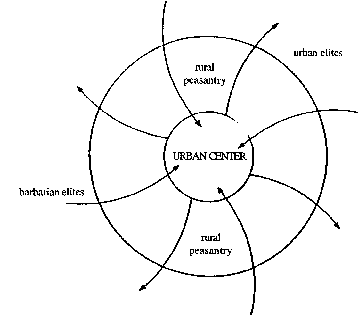
183
classes living in the countryside: all these and more were tried. And all, sooner or later, failed to check
fresh invasion and conquest from the barbarian fringes. This Genghis Khan syndrome therefore matched
270 and opposed the Marco Polo/Dr. Livingstone trade-missionary syndrome, each affecting relalively small
elites, and pulling them in opposite directions. (See Figure 2.)
21) The historical importance of these patterns of elite migration seem very considerable. Efforts at
275 defense and no less persistent efforts at raid and conquest provided a fertile stimulus to administrative and
technical innovation, from the time the war chariot burst upon civilized communities with initially
irresistible force until the present. In addition, the far-ranging movements of warrior, trading, and
280 missionary elites spread familiarity with a considerable variety of high skills across otherwise unbridgeable
distances.
Figure 2. Elite migration pattern for traditional civilization
Skills of China could and did seep westward along paths of communication, just as Roman or Middle
Eastern and Indian skills and ideas could move in the opposite direction along the same communications
paths.
285
22) Whenever established institutions and ideas of a particular civilization failed to function
satisfactorily, the possibility of taking alien notions and skills seriously arose. Much of the cultural history
290 of civilized societies in the Eurasian world turned upon such sporadic receptivity on the part of one
civilization for things imported (and in the process normally also distorted) from an alien, distant civilized
center. From this point of view, the massive interaction between western civilization and the various other
295high cultures of the earth which has been such a conspicuous feature of the last two to three centuries is no
more than the most recent (though perhaps the most dramatic and drastic) such process.
23) Inter-civilizational exchange and stimulus provided a major-perhaps the major — stimulus to
300 change within civilized communities ever since the plurality of civilized cultures became knowable to
suitably located and strategically situated individuals. The ancient Greeks' encounter with the Orient, so
tellingly recorded in Herodotus' pages, and the initial Chinese encounter with the Middle East, more briefly
305 recorded in the pages of the Ssu-ma Ch'ien, the founder of Chinese historiography, have the advantage of
being accessible to us through surviving texts. Other similar encounters ran all the way back to the time
when predynastic Egyptians met ideas and skills emanating from Sumer and saw that they were good, some
310 time before 3000 B.C. Such stimuli drastically altered patterns of cultural growth and often accelerated
developments or turned them into new paths. Or so I argued in The Rise of the West: A History of the
Human Community, which, with its emphasis upon cultural diffusion, may be read as a paean to the world
historical significance of elite migration. (See Figure 3).

